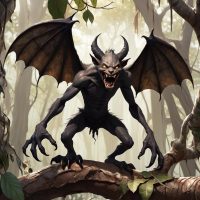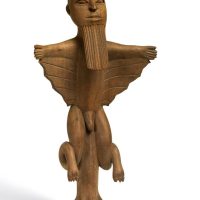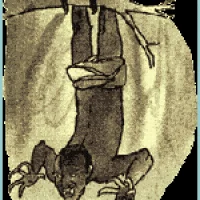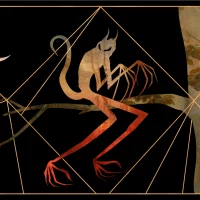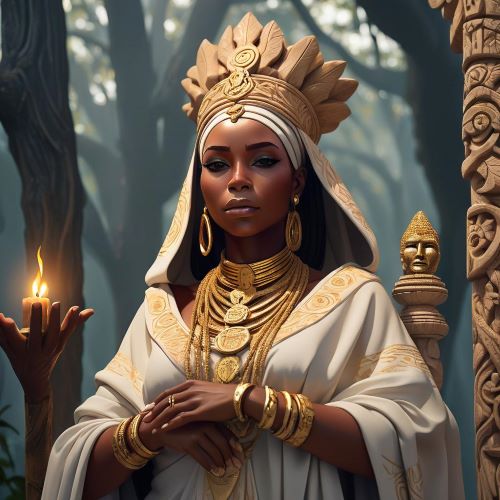Sasabonsam : The Ashanti Vampire
Listen
At a glance
| Description | |
|---|---|
| Origin | Ashanti Mythology |
| Classification | Spirits |
| Family Members | N/A |
| Region | Ghana |
| Associated With | Blood Sucking, Forests |
Sasabonsam
Introduction
Sasabonsam, a captivating figure from Ashanti mythology, is often portrayed as a vampire-like entity inhabiting remote areas and dense forests. It symbolizes both fear and reverence for the unknown, reflecting the Ashanti people’s profound connection with nature and the spiritual realm. This formidable and mysterious being, deeply embedded within Ashanti lore, casts a significant shadow over the consciousness of Ghana’s Ashanti community. Its presence evokes primal fears and aspirations, embodying the intricate depths of human emotions.
This legendary creature, known as Sasabonsam, dwells within the verdant forests of West Africa. Its existence strikes fear into the hearts of those who dare to enter its realm. Sasabonsam’s depiction serves as a stark reminder of the perils lurking within untamed wilderness. Despite belonging to ancient folklore, Sasabonsam’s image continues to resonate, carrying profound meaning even in contemporary times.
Physical Traits
In Ashanti folklore, Sasabonsam emerges as a monstrous entity adorned with formidable physical traits. Its grotesque humanoid form, described in various accounts, features elongated limbs and razor-sharp talons capable of effortlessly tearing flesh. Its visage, marked by piercing red eyes that gleam ominously amidst the forest shadows, instills primal fear in those who encounter it.
Central to Sasabonsam’s depiction is its remarkable wingspan, spanning several meters and facilitating agile navigation through dense forest foliage. These leathery, bat-like wings confer unparalleled speed and grace, with the creature’s emergence accompanied by a chilling rustle that strikes terror into the hearts of observers.
Descriptions of Sasabonsam’s appearance vary, yet all convey a sense of grotesqueness and terror. Standing at approximately five feet tall, its skeletal frame is accentuated by disproportionately long, spindly limbs. Its torso, adorned with fur or scales in some depictions, may also appear hairless with pallid pink skin. Its humanoid face, dominated by bloodshot eyes and a gaping maw lined with iron fangs, exudes menace, further intensified by a singular horn protruding from its forehead.
Among Sasabonsam’s most striking features are its elongated arms, portrayed either as expansive bat-like wings or sinewy appendages employed in ensnaring prey. Its permanently bent legs, sometimes terminating in sharp claws or oppositely pointed feet, add to its eerie countenance. Adorned with black and white spots, Sasabonsam employs camouflage tactics to blend seamlessly with the dappled sunlight filtering through the forest canopy.
Family
Within Ashanti mythology, the Sasabonsam stands as a solitary figure, existing without a known family or lineage, residing in the depths of the forest. While it maintains a solitary existence, Sasabonsam is part of a broader pantheon of spirits, gods, and supernatural beings that populate Ashanti mythology. Some variations of the myth suggest connections between Sasabonsam and other entities in the spiritual realm, hinting at a potential lineage tied to Nyame, the revered sky deity in Ashanti cosmology. This purported divine lineage adds to Sasabonsam’s mystique, positioning it as a formidable force within the pantheon of Ashanti deities.
Despite its solitary nature, Sasabonsam’s habitat within hollow trunks of ancient cotton trees, notably the silk-cotton tree (Ceiba pentandra), reinforces its connection to sacred sites in Ashanti culture. These majestic trees, considered sacred, amplify the mystique and danger associated with Sasabonsam’s presence. While occasional mentions allude to connections between Sasabonsam and other malevolent spirits or witches, these relationships remain nebulous, and Sasabonsam remains a singular entity in Ashanti folklore.
Other names
The Sasabonsam, known within the Akan ethnic group of West Africa, including the Ashanti people, by various names, reflects its diverse cultural significance. One common variant is Asanbosam, emphasizing its arboreal habitat. Other monikers include Sasabonsam Nwuma, denoting its association with the cotton tree, and Sonyame, likely derived from descriptions of its distinctively pointed feet.
Beyond the Akan communities, Sasabonsam is recognized by different names among various ethnic groups and regions. Asanbosam and Asanbosan are among these alternative appellations, maintaining consistency in the creature’s attributes and mythological role. While Sasabonsam predominates in Ashanti folklore, its presence extends across linguistic and geographical borders. Among the Fon people of neighboring Benin, it is known as Aziza, evoking similar sentiments of fear and reverence. These alternative names highlight Sasabonsam’s profound influence across West Africa’s cultural landscape, transcending linguistic and regional boundaries.
Powers and Abilities
Sasabonsam’s mythology brims with accounts of its formidable powers and supernatural prowess, evoking both awe and trepidation in those who encounter it. Among its chief abilities is its mastery over darkness, allowing it to cloak itself in shadows and move silently through the dense forest. Additionally, Sasabonsam is reputed for its superhuman strength and agility, easily overpowering prey and eluding capture with uncanny swiftness. Its acute senses detect even the slightest disturbances within its domain, making it a formidable adversary for wilderness explorers.
Of particular fear is Sasabonsam’s hypnotic gaze, capable of ensnaring unsuspecting travelers and compelling them to obey its sinister commands or lose themselves in the forest forever. These powers, alongside its formidable physical abilities, solidify Sasabonsam’s reputation as a force to be reckoned with in Ashanti mythology. Believed to possess a variety of supernatural powers, Sasabonsam can fly and move silently through the forest. It can bewitch and possess humans, especially those intruding into its territory. Associated with witchcraft, Sasabonsam shape-shifts, assuming different animal forms to deceive its victims.
As a predator, Sasabonsam uses its long, grasping limbs to snatch prey from the ground, ensuring a swift demise with its sharp teeth and claws. Its chilling gaze can inflict illness or death, striking terror into those who meet its bloodshot eyes piercing through the darkness. In some interpretations, Sasabonsam exhibits vampiric tendencies, feeding on the blood of its victims, aligning it with other blood-sucking mythical beings found across various cultures worldwide.
Modern Day Influence
The influence of Sasabonsam persists in modern-day culture, particularly in Ghana, where it features prominently in folk tales and traditional narratives. Serving as a cautionary figure, it warns against disrespecting the natural and spiritual realms. Sasabonsam’s presence extends into popular culture, appearing in books, films, and video games, often depicted as either a formidable foe or a mysterious, supernatural entity. Its significance transcends Ghana, resonating across West African countries, where it continues to be a symbol of respect for the forest and its inhabitants. Artists depict Sasabonsam in various mediums, ensuring its enduring legacy.
Beyond Africa, Sasabonsam influences popular culture, inspiring creatures in video games and fictional works. Its universal appeal as a symbol of fear underscores the potency of folklore in shaping cultural identities. Sasabonsam serves as a poignant reminder of the need to respect nature and exercise caution in unfamiliar environments. Though mythical, its evoked fear remains relevant, highlighting the delicate balance between humanity and the wilderness.
In contemporary Ghanaian culture, Sasabonsam remains a prevalent motif in literature, music, and visual arts, reflecting the enduring connection between the Ashanti people and their cultural heritage. Its myth serves as a cautionary tale, emphasizing the importance of environmental conservation and sustainable practices. As Ghana grapples with these challenges, Sasabonsam’s legend serves as a poignant reminder of humanity’s relationship with the natural world.
Related Images
Frequently Asked Questions
What is lorem Ipsum?
I am text block. Click edit button to change this text. Lorem ipsum dolor sit amet, consectetur adipiscing elit. Ut elit tellus, luctus nec ullamcorper mattis, pulvinar dapibus leo.
What is lorem Ipsum?
I am text block. Click edit button to change this text. Lorem ipsum dolor sit amet, consectetur adipiscing elit. Ut elit tellus, luctus nec ullamcorper mattis, pulvinar dapibus leo.
What is lorem Ipsum?
I am text block. Click edit button to change this text. Lorem ipsum dolor sit amet, consectetur adipiscing elit. Ut elit tellus, luctus nec ullamcorper mattis, pulvinar dapibus leo.
What is lorem Ipsum?
I am text block. Click edit button to change this text. Lorem ipsum dolor sit amet, consectetur adipiscing elit. Ut elit tellus, luctus nec ullamcorper mattis, pulvinar dapibus leo.
What is lorem Ipsum?
I am text block. Click edit button to change this text. Lorem ipsum dolor sit amet, consectetur adipiscing elit. Ut elit tellus, luctus nec ullamcorper mattis, pulvinar dapibus leo.

